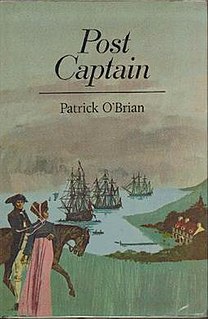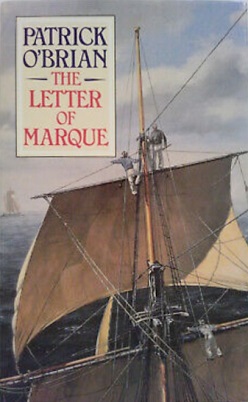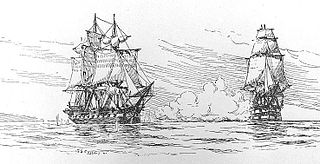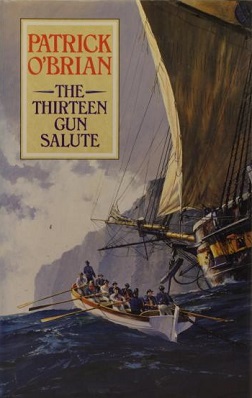
Master and Commander is a nautical historical novel by the English author Patrick O'Brian, first published in 1969 in the US and 1970 in the UK. The book proved to be the start of the 20-novel Aubrey–Maturin series, set largely in the era of the Napoleonic Wars, on which O'Brian continued working until his death in 2000.
John "Jack" Aubrey,, is a fictional character in the Aubrey–Maturin series of novels by Patrick O'Brian. The series portrays his rise from lieutenant to rear admiral in the Royal Navy during the Napoleonic Wars. The twenty -book series encompasses Aubrey's adventures and various commands along his course to flying a rear admiral's flag.

The Surgeon's Mate is the seventh historical novel in the Aubrey–Maturin series written by Patrick O'Brian, first published in 1980. The story is set during the War of 1812 and the Napoleonic Wars.

HMS Surprise is the third historical novel in the Aubrey–Maturin series by Patrick O'Brian, first published in 1973. The series follows the partnership of Captain Jack Aubrey and the naval surgeon Stephen Maturin during the wars against Napoleon's France.

Post Captain is the second historical novel in the Aubrey–Maturin series by Patrick O'Brian, first published in 1972. It features the characters of Captain Jack Aubrey and naval surgeon Stephen Maturin in the early 19th century and is set in the Napoleonic Wars.

Desolation Island is the fifth historical novel in the Aubrey-Maturin series by Patrick O'Brian. It was first published in 1978.

The Ionian Mission is the eighth historical novel in the Aubrey-Maturin series by Patrick O'Brian, first published in 1981. The story is set during the Napoleonic Wars.

The Far Side of the World is the tenth historical novel in the Aubrey-Maturin series by Patrick O'Brian, first published in 1984. The story is set during the Napoleonic Wars and the War of 1812.

The Letter of Marque is the twelfth historical novel in the Aubrey–Maturin series by Patrick O'Brian, first published in 1988. The story is set during the Napoleonic Wars and the War of 1812.

The novel Blue at the Mizzen is the twentieth and last completed historical novel in the Aubrey-Maturin series by Patrick O'Brian, first published in 1999. It is set after the Napoleonic wars, in the fight for Chilean independence from Spain.

The Commodore is the seventeenth historical novel in the Aubrey-Maturin series by British author Patrick O'Brian, first published in 1995. The story is set during the Napoleonic Wars and the War of 1812.

Chesapeake was a 38-gun wooden-hulled, three-masted heavy frigate of the United States Navy. She was one of the original six frigates whose construction was authorized by the Naval Act of 1794. Joshua Humphreys designed these frigates to be the young navy's capital ships. Chesapeake was originally designed as a 44-gun frigate, but construction delays, material shortages and budget problems caused builder Josiah Fox to alter his design to 38 guns. Launched at the Gosport Navy Yard on 2 December 1799, Chesapeake began her career during the Quasi-War with France and later saw service in the First Barbary War.

HMS Leopard was a 50-gun Portland-class fourth rate of the Royal Navy. She served during the French Revolutionary and Napoleonic Wars, and was notable for the actions of her captain in 1807, which were emblematic of the tensions that later erupted in the War of 1812 between Britain and America. She was wrecked in 1814.

Sir Philip Bowes Vere Broke, 1st Baronet was a distinguished officer in the British Royal Navy. During his lifetime he was often referred to as Broke of the Shannon, a reference to his notable command of HMS Shannon in the War of 1812. His most famous military achievement was defeating and capturing the American frigate, USS Chesapeake.

The Thirteen-Gun Salute is the thirteenth historical novel in the Aubrey–Maturin series by Patrick O'Brian, first published in 1989. The story is set during the Napoleonic Wars and the War of 1812.

The capture of USS Chesapeake, also known as the Battle of Boston Harbor, was fought on 1 June 1813, between the Royal Navy frigate HMS Shannon and the United States Navy frigate USS Chesapeake, as part of the War of 1812 between the United States and the United Kingdom. The Chesapeake was captured in a brief but intense action in which 71 men were killed. This was the only frigate action of the war in which there was no preponderance of force on either side.
This is a list of recurring characters in the Aubrey–Maturin series of novels by Patrick O'Brian. As is noted in the articles about each novel, some of these characters are based on real historical persons, while others are purely fictional. Because there is an article describing each novel, links are made to those articles when mentioning the stories in which each character appears. References to page numbers, where they appear, are based upon the W. W. Norton & Company printing of the novels.
Diana Villiers is a fictional character in the Aubrey-Maturin series of novels by Patrick O'Brian. Described as beautiful, mercurial, and entirely unreliable, she is the great love and great sorrow of Stephen Maturin's life.
Captain Henry Lambert RN was an officer of the British Royal Navy during the French Revolutionary and Napoleonic Wars and the War of 1812. During his career, Lambert served in numerous ships and several military actions with success, participating in the capture of Île Bonaparte in the Indian Ocean as second in command under Josias Rowley. Lambert is best known however for being captain of the frigate HMS Java on 29 December 1812 when she was captured in the Mid-Atlantic by USS Constitution during the War of 1812. Lambert was mortally wounded in the battle and died seven days later in Salvador, Brazil.

The Chesapeake–Leopard affair was a naval engagement off the coast of Norfolk, Virginia, on June 22, 1807, between the British fourth-rate HMS Leopard and the American frigate USS Chesapeake. The crew of Leopard pursued, attacked, and boarded the American frigate, looking for deserters from the Royal Navy. Chesapeake was caught unprepared and after a short battle involving broadsides received from Leopard, the commander of Chesapeake, James Barron, surrendered his vessel to the British. Chesapeake had fired only one shot.
















